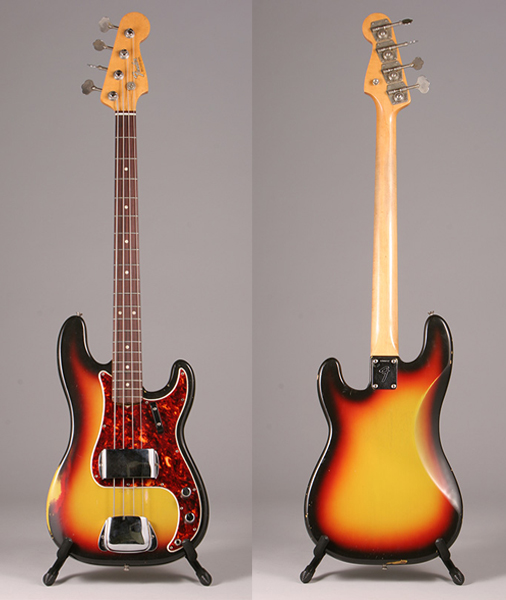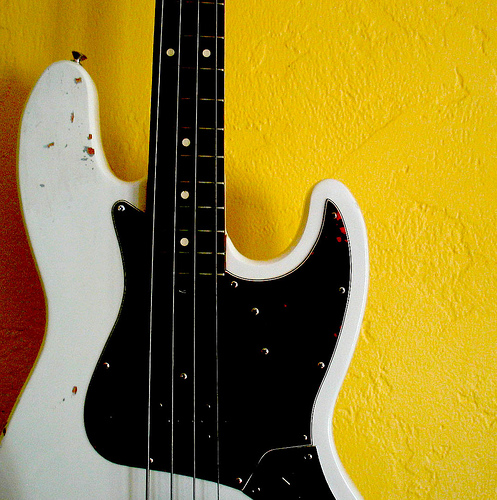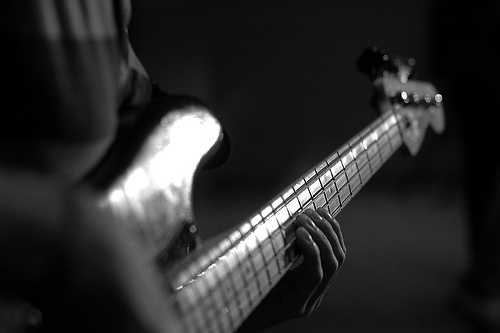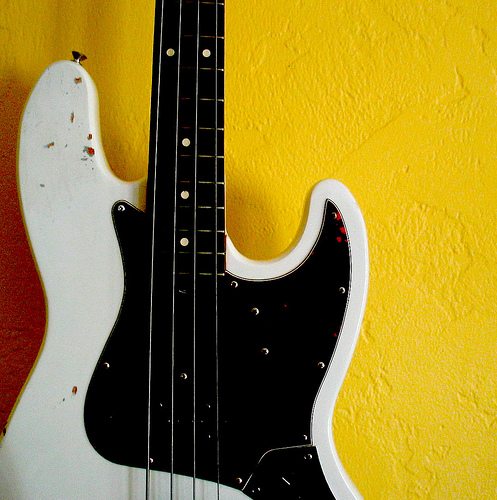Last time on Bass Tone we looked at the daddy of all basses: the upright. Though it has many wonderful strengths as an instrument, there are some frustrating limitations, particularly for the non classically trained musician. We left off in the early 1950s, when a man called Leo Fender stepped in…

Fender Precision Bass
Released in 1951, Leo Fender’s “Precision” bass revolutionized bass playing. Its radical design maintained the tuning of the upright bass, but reduced the scale length from a whopping 42 inches to a manageable 34, added guitar-style frets on a bolted-on neck, used a sleek solid ash body, and flipped the whole thing on its side. A mark of Leo Fender’s genius is that the design decisions he made on the Precision have become the de facto standard of bass design. With only minor revisions, the Fender P-Bass—as it is affectionately known—is, along with its sister, the Fender Jazz (or J-Bass), still the most popular bass guitar in the world.
In this clip the open strings of an electric bass are played from E to G.
The innovative construction of Fender’s electric bass revolutionized music. Suddenly, the bass became portable and affordable, and any guitarist could quickly learn to double on bass. He chose the name “Precision” because the fretted neck allows for perfect pitching of notes every time, even for beginners.
This had two immediate effects:
- The bass became a pretty easy instrument to pick up, leading to the popular trend of bands putting the cool one with no musical ability on bass.
- A skilled bass player could now tear up the fret board like a guitarist! It isn’t an exaggeration to say that modern musical styles such as funk and metal simply could not exist without the high-octane low end enabled by Fender’s magical melding of wood and wire.
A Note on Sound Clips
I played the electric bass recordings for this article using a five-string Warwick Streamer Double Buck—you can see me playing it in my profile pic. This is a bolt-necked bass with a construction similar to the Fender basses already described. I recorded the examples via an EBS HD350 amplifier acting as a preamplifier and EQ.

Fender Jazz Bass (Photo: cdsessums@Flickr)
Bass Pickups
The P and J basses have a very similar construction, with the main difference being the P Bass’s unusual Z-shaped humbucking magnetic pickup, which gives this bass a fat rock sound. The strange shape was allegedly chosen to throw Gibson off the scent, as they still held the patents for this type of pickup and could have demanded licence fees! The J Bass features a pair of single-coil pickups, which produce a more articulate sound.
The following clip demonstrates a bass with a switchable pickup, changing from single-coil to a dual-coil humbucker sound. Notice, when switching from single-coil to humbucker, the volume, especially in the low frequencies, increases.
If you are listening on headphones, you may notice some background noise on the single-coil sound. Single coils are notorious for picking up electrical noise from nearby equipment. The humbucker was invented to prevent this (see the Humbucker Wikipedia article if you want to know the science behind that).
The sound a pickup produces depends on other factors in addition to how many coils it has. The type of magnet, the number of wraps of wire, and the pickup’s size all are important. Most musicians consider so-called “alnico” magnets to sound the best. Bass players typically do not prefer the super-high-output, overwound pickups that most rock guitarists do, because active basses already produce very high output (more on that in a moment). If you like the feel of your bass but want to improve the sound, fitting a different kind of pickup is the best option.
The two pickups—one near the bridge and one near the neck—of a J Bass have individual volume controls. This innovation came about because bassists wanted to blend the more articulate sound of the bridge pickup and the fatter sound of neck pickup to produce a sonic sweet spot. The desirability of these in-between tones lessened the importance of switching from one to the other, so basses usually feature either individual volume controls or a blend control that fades input from one pickup while boosting it from the other.

In the clip above, listen for the fading in and out of the bridge and neck pickups while I play a phrase several times.
“Active” Basses
Bass players tend to be more accepting of modern technology than guitarists are (though there is still a huge market for retro designs). Modern bass guitar designs are typically “active”, meaning they have a battery-powered preamplifier built in, which boosts the output level for a cleaner signal, and can provide two or three bands of equalization.
In these clips, I adjust the bass and treble controls of an active bass while playing a repeated phrase. Listen for how boosting and cutting the treble affects the sound, and then compare with boosting and cutting the bass.
First, the phrase is played with maximum treble cut. The control is then slowly moved to a neutral position, and then to maximum boost. A bass with more treble will stand out more in the mix, but notice how more treble also increases the amount of unwanted string noise.
Next the phrase is played with maximum bass cut. The control is then slowly moved to a neutral position, and then to maximum bass boost. At maximum cut the bass sounds weedy and lacking in low frequencies, but at maximum boost it becomes muddy and indistinct.
With both of the above clips, listen and try to identify where you think the ideal balance is.
Even if your bass has only one pickup and no tone controls, you can alter your tone by your choice of fingering. Unlike a piano, where each note comes from only one key, on the bass you can play the same note in more than one position. For example, using a higher fret on a thicker (lower) string will result in a fatter sound.
In this clip, I start by playing the open G string, and follow by fingering the fifth fret of the D string, the tenth fret of the A string, the fifteenth fret of the E string, and finally the twentieth fret of the B string. Notice the change from bright articulation of the open G to the thumpy fatness when I play the same note on the B string.
Now you have an idea of the range of tones which the electric bass itself can typically provide, and the kind of flexibility the electric bass offers over its hollow-bodied father, the upright!
We’ll continue next time with how different playing styles can affect the tone of the bass, and the innovative ways famous bass players have eked out new sounds from their instruments.
Also, look out for the next episode of the Bass Tone Podcast later this week, featuring more info and lots more sound examples for this topic!
Any questions, comments or suggestions? Don’t be shy!








